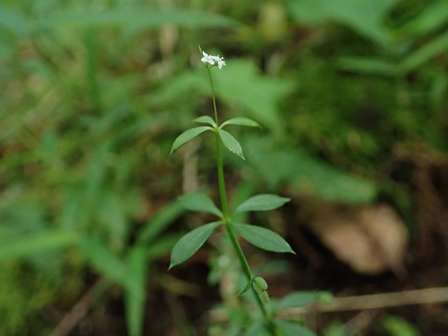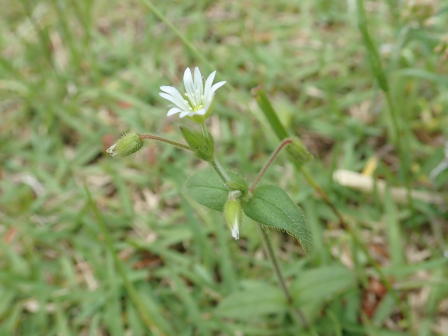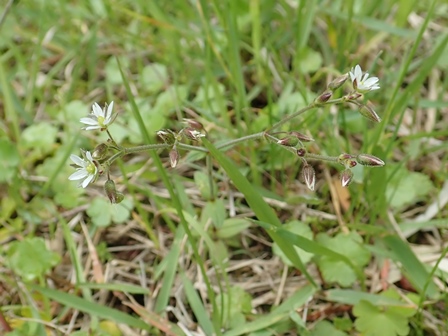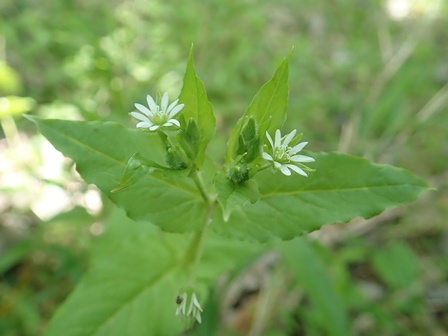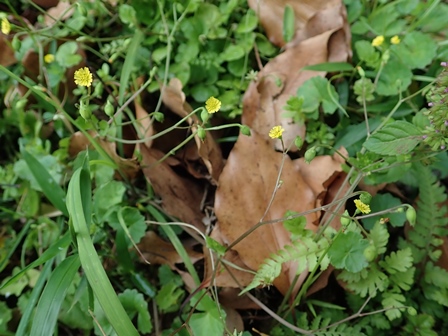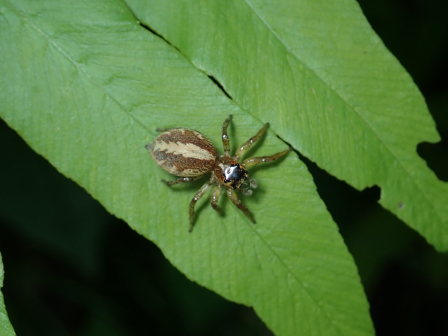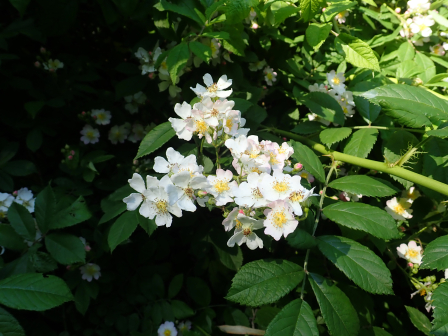フィールド日記
2022.06.03
キクムグラ
ファーストオークヒルとセカンドオークヒルの間の林道でキクムグラが咲いていました。似ている仲間が多いですが、本種は花の下に苞葉があるのが特徴です。学名をGalium kikumuguraといい、和名がそのまま学名となっていることが分かります。
"Kiku-Mugura (キクムグラ)" plants are in bloom on the path between the First and Second Oak Hill. There are many species similar to them, but you can tell "Kiku-Mugura" from others by the fact that they have a bract leaf beneath the flowers. Their scientific name is "Galium kikumugura" and it originates from their Japanese name "KiKu-Mugura".
2022.05.31
ケミミナグサ
セカンドオークヒルに、ミミナグサに混じってケミミナグサが咲いています。『神奈川県植物誌2018電子版』によると、ミミナグサよりもがく片が大きく、苞葉の縁が白膜質になるものをオオミミナグサといい、さらに腺毛をもつものをケミミナグサと呼ぶそうです。写真の個体は上記の特徴を満たすことから、ケミミナグサと判断しました。
"Ke-Mimi-Na-Gusa (ケミミナグサ)" plants are in bloom with "Mimi-Na-Gusa (ミミナグサ)" plants in the Second Oak Hill. According to "Flora of Kanagawa 2018 online version", the ones that have sepals larger than those of "Mimi-Na-Gusa (ミミナグサ)" and have white membrane-like margins on the bract leaves are called "Oo-Mimi-Na-Gusa (オオミミナグサ)". In addition, the ones that have glandular hair are called "Ke-Mimi-Na-Gusa (ケミミナグサ)". The one in the photo has the features mentioned above, so I identified it as the "Ke-Mimi-Na-Gusa (ケミミナグサ)".
2022.05.27
ミミナグサ
セカンドオークヒルでミミナグサが咲いています。和名のミミは耳の意味で、葉の形がネズミなどの動物の耳の形に見えることに由来します。また、和名のナ(菜)は本種が食べられることを示しています。
"Mimi-Na-Gusa (ミミナグサ)" plants are in bloom in the Second Oak Hill. "Mimi (ミミ)" in its name means "ear" and comes from the fact that the shape of their leaves looks like ears of an animal such as a rat. "Na (ナ)" in its name indicates that this species is edible.
2022.05.24
ウシハコベ
共生の森でウシハコベが咲いていました。ハコベに似ていて、より大型であることから牛(ウシ)をつけてウシハコベとなったといわれています。ハコベのなかまは雌しべが3つに分かれるのに対し、ウシハコベは5つに分かれることも見分けるポイントになります。
"Ushi-Hakobe (ウシハコベ)" plants are in bloom in the Kyoseinomori(共生の森). They are larger than the close relative species "Hakobe (ハコベ)". People added "Ushi (ウシ)", which means "cow", to its name "Hakobe". You can tell "Ushi-Hakobe" from others belonging to the "Hakobe" group by the fact that the pistils of "Ushi-Hakobe" are divided into five, while the others' pistils are divided into three.
2022.05.20
ヤブタビラコ
駐車場の近くにヤブタビラコが咲いていました。茎はやわらかく、倒れたり、斜上したりしながら広がります。
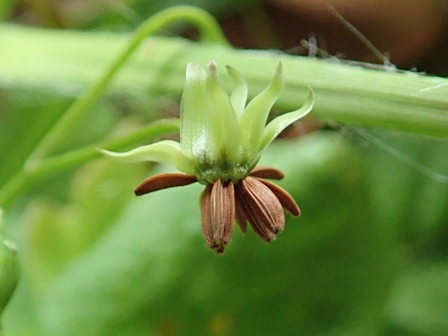
"Yabu-Tabirako (ヤブタビラコ)" plants are in bloom near the parking area. Their stems are soft, so they grow crawling and standing up.
2022.05.17
タニギキョウ
裏道でタニギキョウが咲いていました。和名の通り、山地の谷沿いなどの湿った木陰に生えるキキョウ科の多年草です。茎は柔らかく、地面をはい、上部は立ち上がって小さい白い花をつけます。
"Tani-Gikyou (タニギキョウ)" plants are in bloom on the back road. The name represents the fact that they grow in humid shady places like paths along the valleys and belong to the group of "Kikyou (キキョウ)" plants. Their soft stems crawl on the ground, and the upper parts of them stand up and bear small white flowers.
2022.05.13
デーニッツハエトリ
裏道でデーニッツハエトリを見つけました。ハエトリグモのなかまは、とても良い視力をもっており、クモの巣はつくらずに、眼で見て獲物に飛びつきます。本種は、草地や雑木林の草の上でよく見られます。
I found a jumping spider called "Plexippoides doenitzi (デーニッツハエトリ)" on the back road. Jumping spiders have good eyesight, so they don't build webs. They catch their prey with their eyes. This species is often seen in grass fields and on the grass in forests.
2022.05.10
ノイバラ
裏道でノイバラが咲いていました。学名をRosa multifloraといい、ラテン語でたくさんの花をつけるバラを意味します。ノイバラはこのたくさんの花をつける性質などからヨーロッパで園芸品種の改良に用いられ、現在の栽培バラの祖先として重要な役割を果たしたそうです。
"Noibara (ノイバラ)" trees are in bloom on the back road. They are scientifically called "Rosa multiflora" and it means "rose that bears many flowers" in Latin. Because of their characteristic of bearing many flowers, they were used in Europe for the improvement of roses. They played an important role as an ancestral species of cultivated roses.
2022.05.06
コバンソウ
裏門の近くでコバンソウ見つけました。和名は小穂のかたちを小判に見立てたものです。地中海沿岸原産の帰化植物で、明治時代に渡来したと言われています。ドライフラワーや花壇などに利用されています。
I found "Koban-Sou" plants near the back gate. The name comes from the fact that their spikelets look like oval gold coins called "Koban" in Japanese. They originally came from a Mediterranean region and it is said that they were firstly brought to Japan during the Meiji era. They are used for dry flowers and planted in gardens.
2022.05.03
ツマキチョウ
共生の森でツマキチョウを見つけました。幼虫の食草はアブラナ科の植物です。かつては減少傾向にあったものの、帰化植物を食草とすることで、近年は都市部でも再びみられるようになったそうです。
I found a butterfly called "Tsumaki-Chou (ツマキチョウ)" in the Kyoseinomori(共生の森). Their larvae eat cruciferous plants. They once reduced in number, but now they seem to be increasing again by eating naturalized plants and can be seen even in urban areas.


